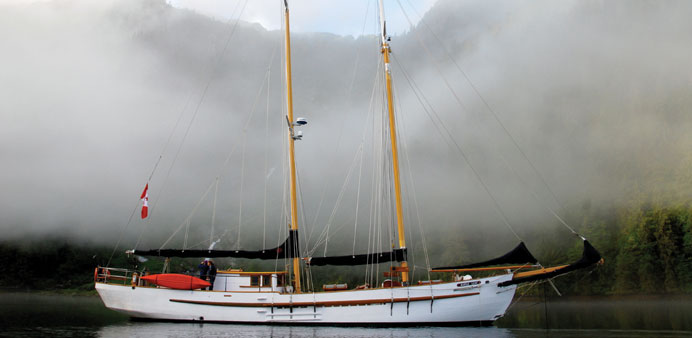By Ole Helmhausen
The bear guide, Marven Robinson, is someone you could set your watch to. A member of the Gitga’at First Nations tribe, he skippered his motorboat into the small bay off Gribbell Island where the Maple Leaf had anchored overnight just as the shipboard clock struck nine.
The passengers of the two-masted schooner named after Canada’s national emblem — about a dozen international tourists hankering for adventure — were already waiting at the railing in rubber boots and layered clothing.
Canada’s Pacific Northwest coast can quickly turn inclement, particularly in spring and autumn. “We’ll see what happens today,” said Robinson during the greetings on land.
He would not promise anything. How could he? Gribbell Island is big and uninhabited, covered with forests, mountains and rivers. And what the tourists had come to see there was rare: black bears with white coats, known as “spirit bears” or “Kermode bears.”
“Mother Nature directs the show here,” Robinson remarked. “We’re just the cable carriers.”
With that he tromped off with the tourists in tow. A narrow path along a slow stream led to a makeshift observation platform that overlooked fallen tree trunks and scattered boulders a bit further upstream.
“Now we’ve got to be quiet and wait,” said Robinson, smiling and making himself comfortable on one of the benches. “The spirit bears could turn up any minute — or not.”
Although the Maple Leaf had thus far completed just three-fourths of its cruise between Vancouver Island and the southern tip of the Alaskan panhandle, all of the passengers were already describing their experience with every conceivable superlative.
For nearly a week, Captain Greg Shea and his crew had steered the 92ft vessel, built in 1904, through the spectacular natural scenery dubbed the Great Bear Rainforest by environmental groups in the 1990s.
Sandwiched between the Pacific Ocean and Coast Mountains, this magical region, North America’s last relatively intact temperate rainforest and home to its last large populations of grizzly bears, is a place of deep fjords, snow-covered mountains and innumerable uninhabited islands.
“We don’t promise our guests that they’ll see bears,” Shea warned, immediately adding that in all his years at the helm of the Maple Leaf he had always succeeded in encountering some bears, not to mention other, no less fascinating wildlife.
Humpback whales were spotted almost daily during the cruise. Four of the gentle giants gave a gala evening performance in Bishop Bay’s glassy waters. Off Gil Island, black-and-white Dall’s porpoises shot arrow-like through the waves.
Herring-hunting orcas slapped the water with their tail flukes to keep hungry ospreys from swiping their dinner. Colonies of sea lions clamoured on sea-washed rocks, mountain goats perched on cliffs high above the ship, wolf tracks lay in the mud of river mouths. Every time the passengers and crew went ashore was an expedition into the unknown.
But the main attraction was the spirit bears, whose number is estimated at only 400. Their white fur comes from a recessive gene, much like red hair in humans. Their sole habitat is the Great Bear Rainforest, most of them living on Princess Royal Island and nearby islands such as Gribbell.
The tourists on the observation platform, meanwhile, were growing increasingly impatient. Having enthusiastically photographed the first black bears they saw fishing for salmon, they now ignored them. Everyone was waiting for the stars of the rainforest.
“They’re probably taking a nap,” Robinson said. No sooner had he spoken than someone whispered excitedly, “A spirit bear!”
About 70m upstream, a large white bear had emerged from the green underbrush. Furiously swinging its paws, it was pursuing a salmon through shallow water, but the fish got away.
The bear climbed onto a fallen tree trunk and calmly scanned the water. For a few minutes nothing happened. Then it dove into the water with a big belly flop and resurfaced a few seconds later with a huge salmon in its mouth.
After its meal, the bear leisurely padded past the Maple Leaf’s passengers — so close that they could hear its stomach rumbling. No one said a word. No one made a move. A short distance upstream it was joined by an ordinary black bear.
The tension on the platform finally gave way to giggling. Every face was happy. Everyone slapped everyone else on the back. Robinson beamed. “It doesn’t get any better than that, does it?” he said. It had begun to rain. No one noticed. — DPA
1 One of the sought-after white bears in the Great Bear Rainforest of Canada. The animals are black bears of a line that has undergone a genetic mutation.

Mist gathers around the Maple Leaf, a schooner that cruises off the western coast of Canada.
